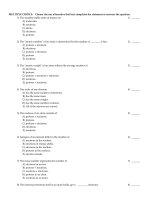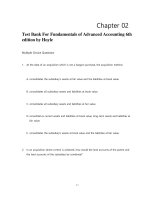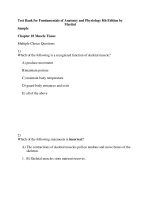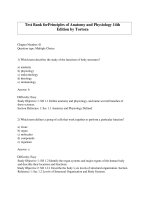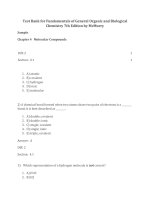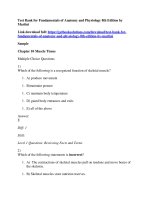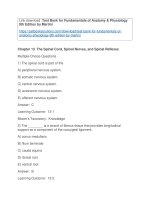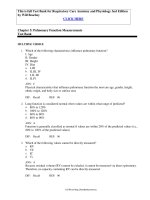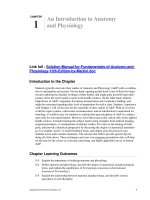Test bank for fundamentals of anatomy and physiology 11e c08 The Appendicular Skeleton
Bạn đang xem bản rút gọn của tài liệu. Xem và tải ngay bản đầy đủ của tài liệu tại đây (912.63 KB, 30 trang )
Chapterȱ8
TheȱAppendicularȱSkeleton
Multiple Choice Questions
1) Whichȱofȱtheȱfollowingȱbonesȱisȱnot partȱofȱtheȱappendicularȱskeleton?
A) scapula
B) tibia
C) sacrum
D) coxalȱbones
E) clavicles
Answer: C
LearningȱOutcome: 8-1
BloomȇsȱTaxonomy: Remembering
2) Theȱmedialȱendȱofȱtheȱclavicleȱisȱalsoȱknownȱasȱtheȱ________ȱend.
A) acromial
B) sternal
C) coracoidal
D) manubrial
E) scapular
Answer: B
LearningȱOutcome: 8-1
BloomȇsȱTaxonomy: Remembering
3) Whichȱofȱtheȱfollowingȱisȱtheȱtermȱforȱtheȱarticulationȱofȱtheȱclaviclesȱwithȱtheȱsternum?
A) acromioclavicularȱjoint
B) sternoclavicularȱjoint
C) acromiosternalȱjoint
D) sternoacromialȱjoint
E) costalclavicularȱjoint
Answer: B
LearningȱOutcome: 8-1
BloomȇsȱTaxonomy: Remembering
4) Whichȱofȱtheȱfollowingȱisȱtheȱtermȱforȱtheȱarticulationȱofȱtheȱclaviclesȱwithȱtheȱscapulae?
A) acromioclavicularȱjoint
B) sternoclavicularȱjoint
C) acromiosternalȱjoint
D) sternoacromialȱjoint
E) costalclavicularȱjoint
Answer: A
LearningȱOutcome: 8-1
BloomȇsȱTaxonomy: Remembering
Copyrightȱ©ȱ2018ȱPearsonȱEducation,ȱInc.
Chapterȱ8ȱȱTheȱAppendicularȱSkeletonȱȱȱ235
5) Theȱacromionȱisȱcontinuousȱwithȱaȱprominentȱridgeȱofȱboneȱonȱtheȱposteriorȱsurfaceȱofȱthe
scapulaȱknownȱasȱthe
A) conoidȱtubercle.
B) glenoidȱcavity.
C) coracoidȱprocess.
D) spine.
E) inferiorȱangle.
Answer: D
LearningȱOutcome: 8-1
BloomȇsȱTaxonomy: Remembering
6) Theȱanteriorȱsurfaceȱofȱtheȱscapulaȱisȱsmoothȱandȱconcave.ȱTheȱnameȱofȱtheȱconcave
depressionȱisȱthe
A) supraspinousȱfossa.
B) infraspinousȱfossa.
C) subscapularȱfossa.
D) subspinousȱfossa.
E) glenoidȱfossa.
Answer: C
LearningȱOutcome: 8-1
BloomȇsȱTaxonomy: Remembering
7) Theȱscapulaȱisȱroughlyȱtriangularȱinȱshape.ȱWhichȱofȱtheȱfollowingȱareȱcorrectȱtermsȱforȱthe
borders?
A) superior,ȱmedial,ȱandȱlateralȱborders
B) dorsalȱandȱcostalȱborders
C) anterior,ȱposterior,ȱandȱsuperiorȱborders
D) scapular,ȱsternal,ȱandȱclavicularȱborders
E) pectoralȱborders
Answer: A
LearningȱOutcome: 8-1
BloomȇsȱTaxonomy: Remembering
8) Theȱonlyȱdirectȱconnectionȱbetweenȱtheȱpectoralȱgirdleȱandȱtheȱaxialȱskeletonȱisȱwhereȱthe
A) clavicleȱarticulatesȱwithȱtheȱhumerus.
B) clavicleȱarticulatesȱwithȱtheȱmanubriumȱofȱtheȱsternum.
C) coxalȱbonesȱarticulateȱwithȱtheȱfemur.
D) vertebralȱcolumnȱarticulatesȱwithȱtheȱsacrum.
E) clavicleȱarticulatesȱwithȱtheȱxiphoidȱprocess.
Answer: B
LearningȱOutcome: 8-1
BloomȇsȱTaxonomy: Understanding
Copyrightȱ©ȱ2018ȱPearsonȱEducation,ȱInc.
236ȱȱȱTestȱBankȱforȱFundamentalsȱofȱAnatomyȱ&ȱPhysiology,ȱ11e
9) Theȱclavicleȱarticulatesȱwithȱthe
A) coracoidȱprocessȱandȱtheȱhumerus.
B) glenoidȱcavityȱandȱscapularȱspine.
C) coracoidȱprocessȱandȱacromion.
D) manubriumȱandȱxiphoidȱprocess.
E) manubriumȱandȱacromion.
Answer: E
LearningȱOutcome: 8-1
BloomȇsȱTaxonomy: Remembering
10) Whichȱofȱtheȱfollowingȱconstitutesȱtheȱpectoralȱgirdle?
A) claviclesȱonly
B) claviclesȱandȱscapulae
C) clavicles,ȱscapulae,ȱandȱhumerus
D) clavicles,ȱscapulae,ȱhumerus,ȱradius,ȱandȱulna
E) clavicles,ȱscapulae,ȱhumerus,ȱradius,ȱulna,ȱandȱcarpalȱbones
Answer: B
LearningȱOutcome: 8-1
BloomȇsȱTaxonomy: Remembering
11) Whichȱofȱtheȱfollowingȱisȱlocatedȱclosest toȱtheȱjugularȱnotch?
A) medialȱendȱofȱscapula
B) medialȱendȱofȱclavicle
C) lateralȱendȱofȱscapula
D) lateralȱendȱofȱclavicle
E) xiphoidȱprocess
Answer: B
LearningȱOutcome: 8-1
BloomȇsȱTaxonomy: Understanding
12) Whichȱofȱtheȱfollowingȱisȱmostȱcommonlyȱfracturedȱinȱaȱfall?
A) radius
B) scapula
C) clavicle
D) sternum
E) glenoidȱcavity
Answer: C
LearningȱOutcome: 8-1
BloomȇsȱTaxonomy: Understanding
13) Theȱappendicularȱskeletonȱincludesȱtheȱbonesȱofȱtheȱupperȱandȱlowerȱextremitiesȱandȱtheir
supportingȱelementsȱcalled
A) joints.
B) girdles.
C) sutures.
D) ballȱandȱsocket.
E) rotatorȱcuffs.
Answer: B
LearningȱOutcome: 8-1
BloomȇsȱTaxonomy: Remembering
Copyrightȱ©ȱ2018ȱPearsonȱEducation,ȱInc.
Chapterȱ8ȱȱTheȱAppendicularȱSkeletonȱȱȱ237
14) Twoȱprominentȱfeaturesȱofȱtheȱclavicleȱareȱtheȱconoidȱtubercleȱatȱtheȱlateralȱendȱandȱthe
________ȱtuberosityȱatȱtheȱmedialȱend.
A) costal
B) sternal
C) acromial
D) deltoid
E) scapular
Answer: A
LearningȱOutcome: 8-1
BloomȇsȱTaxonomy: Remembering
15) Theȱscapulaȱarticulatesȱwithȱtheȱhumerusȱatȱtheȱ________ȱjoint.
A) acromiogleno
B) acromiohumoral
C) glenohumoral
D) glenoscapular
E) humeroscapular
Answer: C
LearningȱOutcome: 8-1
BloomȇsȱTaxonomy: Remembering
16) Theȱ________ȱareȱS-shapedȱbonesȱthatȱarticulateȱlateralȱtoȱtheȱjugularȱnotch.
A) scapulae
B) manubria
C) coracoidȱprocesses
D) clavicles
E) acromialȱprocesses
Answer: D
LearningȱOutcome: 8-1
BloomȇsȱTaxonomy: Remembering
Copyrightȱ©ȱ2018ȱPearsonȱEducation,ȱInc.
238ȱȱȱTestȱBankȱforȱFundamentalsȱofȱAnatomyȱ&ȱPhysiology,ȱ11e
Figureȱ8-1ȱTheȱScapula
UseȱFigureȱ8-1ȱtoȱanswerȱtheȱfollowingȱquestions:
17) IdentifyȱtheȱstructureȱlabeledȱȈ1.Ȉ
A) spineȱofȱscapula
B) scapularȱprocess
C) acromion
D) coracoidȱprocess
E) scapularȱnotch
Answer: D
LearningȱOutcome: 8-1
BloomȇsȱTaxonomy: Analyzing
Copyrightȱ©ȱ2018ȱPearsonȱEducation,ȱInc.
Chapterȱ8ȱȱTheȱAppendicularȱSkeletonȱȱȱ239
18) IdentifyȱtheȱstructureȱlabeledȱȈ2.Ȉ
A) glenoidȱcavity
B) acetabulum
C) scapularȱcavity
D) subscapularȱfossa
E) rotatorȱcup
Answer: A
LearningȱOutcome: 8-1
BloomȇsȱTaxonomy: Analyzing
19) Whichȱstructureȱisȱtheȱacromion?
A) 1
B) 2
C) 3
D) 4
E) 5
Answer: E
LearningȱOutcome: 8-1
BloomȇsȱTaxonomy: Analyzing
20) IdentifyȱtheȱstructureȱlabeledȱȈ7.Ȉ
A) acromion
B) scapularȱprocess
C) spineȱofȱscapula
D) coracoidȱprocess
E) scapularȱnotch
Answer: C
LearningȱOutcome: 8-1
BloomȇsȱTaxonomy: Analyzing
21) WhatȱboneȱarticulatesȱonȱtheȱstructureȱlabeledȱȈ2Ȉ?
A) femur
B) clavicle
C) humerus
D) manubrium
E) radius
Answer: C
LearningȱOutcome: 8-1
BloomȇsȱTaxonomy: Analyzing
22) Whichȱofȱtheȱfollowingȱfeaturesȱisȱlocatedȱnearȱtheȱproximalȱendȱofȱtheȱhumerus?
A) medialȱepicondyle
B) lateralȱepicondyle
C) greaterȱtubercle
D) olecranonȱfossa
E) capitulum
Answer: C
LearningȱOutcome: 8-2
BloomȇsȱTaxonomy: Remembering
Copyrightȱ©ȱ2018ȱPearsonȱEducation,ȱInc.
240ȱȱȱTestȱBankȱforȱFundamentalsȱofȱAnatomyȱ&ȱPhysiology,ȱ11e
23) Theȱdepressionȱonȱtheȱposteriorȱsurfaceȱatȱtheȱdistalȱendȱofȱtheȱhumerusȱisȱthe
A) olecranonȱfossa.
B) coronoidȱfossa.
C) radialȱfossa.
D) intertubercularȱgroove.
E) radialȱgroove.
Answer: A
LearningȱOutcome: 8-2
BloomȇsȱTaxonomy: Remembering
24) Theȱulnarȱnerveȱisȱexposedȱwhenȱitȱcrossesȱtheȱposteriorȱsurfaceȱofȱwhatȱprocess?
A) greaterȱtubercle
B) lesserȱtubercle
C) deltoidȱtuberosity
D) medialȱepicondyle
E) trochlea
Answer: D
LearningȱOutcome: 8-2
BloomȇsȱTaxonomy: Remembering
25) Theȱdeltoidȱmuscleȱattachesȱtoȱwhatȱprocess?
A) radialȱgroove
B) deltoidȱfossa
C) intertubercularȱgroove
D) deltoidȱtuberosity
E) greaterȱtubercle
Answer: D
LearningȱOutcome: 8-2
BloomȇsȱTaxonomy: Remembering
26) Theȱshortȱprojectionsȱatȱtheȱdistalȱendsȱofȱbothȱtheȱradiusȱandȱulnaȱareȱthe
A) styloidȱprocesses.
B) radialȱheadȱandȱulnarȱhead.
C) radialȱheadȱandȱolecranon.
D) medialȱandȱlateralȱepicondyles.
E) medialȱandȱlateralȱmalleolus.
Answer: A
LearningȱOutcome: 8-2
BloomȇsȱTaxonomy: Remembering
27) Whichȱofȱtheȱfollowingȱprocessesȱisȱnot foundȱonȱtheȱulna?
A) styloidȱprocessȱofȱulna
B) olecranon
C) radialȱnotch
D) coronoidȱprocess
E) trochlea
Answer: E
LearningȱOutcome: 8-2
BloomȇsȱTaxonomy: Remembering
Copyrightȱ©ȱ2018ȱPearsonȱEducation,ȱInc.
Chapterȱ8ȱȱTheȱAppendicularȱSkeletonȱȱȱ241
28) Theȱattachmentȱsiteȱforȱtheȱbicepsȱbrachiiȱmuscleȱtoȱtheȱradiusȱisȱatȱthe
A) deltoidȱtuberosity.
B) greaterȱtubercle.
C) radialȱtuberosity.
D) brachialȱtuberosity.
E) styloidȱprocessȱofȱtheȱradius.
Answer: C
LearningȱOutcome: 8-2
BloomȇsȱTaxonomy: Remembering
29) Whichȱofȱtheȱfollowingȱisȱnotȱoneȱofȱtheȱfourȱproximalȱcarpalȱbones?
A) scaphoid
B) lunate
C) pisiform
D) hamate
E) triquetrum
Answer: D
LearningȱOutcome: 8-2
BloomȇsȱTaxonomy: Remembering
30) Theȱradiusȱandȱulnaȱareȱboundȱtoȱeachȱotherȱbyȱa(n)ȱ________ȱligament.
A) radioulnar
B) interosseous
C) antebrachial
D) lateromedial
E) intrabrachial
Answer: B
LearningȱOutcome: 8-2
BloomȇsȱTaxonomy: Remembering
31) Theȱtrochleaȱisȱlocatedȱonȱthe
A) tibia.
B) humerus.
C) radius.
D) scapula.
E) ulna.
Answer: B
LearningȱOutcome: 8-2
BloomȇsȱTaxonomy: Remembering
32) Theȱbonesȱofȱtheȱforearm,ȱorȱ________,ȱconsistȱofȱtheȱradiusȱandȱulna.
A) olecranonȱregion
B) brachium
C) antecubitalȱregion
D) antebrachium
E) cubitalȱregion
Answer: D
LearningȱOutcome: 8-2
BloomȇsȱTaxonomy: Understanding
Copyrightȱ©ȱ2018ȱPearsonȱEducation,ȱInc.
242ȱȱȱTestȱBankȱforȱFundamentalsȱofȱAnatomyȱ&ȱPhysiology,ȱ11e
33) Identifyȱtheȱmismatchedȱpair.
A) lunate;ȱcomma-shaped
B) triquetrum;ȱboat-shaped
C) pisiform;ȱpea-shaped
D) trapezoid;ȱwedge-shaped
E) hamate;ȱhook-shaped
Answer: B
LearningȱOutcome: 8-2
BloomȇsȱTaxonomy: Remembering
34) Inȱtheȱanatomicalȱposition,ȱtheȱulnaȱisȱlocatedȱ________ȱtoȱtheȱradius.
A) distal
B) proximal
C) medial
D) superior
E) lateral
Answer: C
LearningȱOutcome: 8-2
BloomȇsȱTaxonomy: Remembering
35) Theȱcondyleȱofȱtheȱhumerusȱconsistsȱofȱthe
A) medialȱandȱlateralȱepicondyles.
B) trochleaȱandȱolecranonȱfossa.
C) capitulumȱandȱtrochlea.
D) headȱandȱneck.
E) capitulumȱandȱcoronoidȱprocess.
Answer: C
LearningȱOutcome: 8-2
BloomȇsȱTaxonomy: Remembering
36) Whichȱofȱtheȱfollowingȱsurfaceȱfeaturesȱisȱfoundȱonȱtheȱradius?
A) olecranon
B) coronoidȱprocess
C) trochlearȱnotch
D) radialȱnotch
E) ulnarȱnotch
Answer: E
LearningȱOutcome: 8-2
BloomȇsȱTaxonomy: Remembering
37) Thereȱareȱ________ȱcarpalȱbonesȱlocatedȱinȱtheȱwrist,ȱwhichȱformȱ________ȱrowsȱofȱbones.
A) 2;ȱ8
B) 10;ȱ3
C) 4;ȱ2
D) 8;ȱ2
E) 6;ȱ2
Answer: D
LearningȱOutcome: 8-2
BloomȇsȱTaxonomy: Remembering
Copyrightȱ©ȱ2018ȱPearsonȱEducation,ȱInc.
Chapterȱ8ȱȱTheȱAppendicularȱSkeletonȱȱȱ243
38) Theȱbonesȱthatȱformȱtheȱfingersȱareȱthe
A) carpals.
B) tarsals.
C) metacarpals.
D) metatarsals.
E) phalanges.
Answer: E
LearningȱOutcome: 8-2
BloomȇsȱTaxonomy: Remembering
39) Theȱroughȱsurfaceȱfeatureȱpresentȱalongȱtheȱlateralȱborderȱofȱtheȱshaftȱofȱtheȱhumerusȱisȱthe
A) radialȱgroove.
B) medialȱepicondyle.
C) lateralȱepicondyle.
D) deltoidȱtuberosity.
E) coronoidȱprocess.
Answer: D
LearningȱOutcome: 8-2
BloomȇsȱTaxonomy: Remembering
40) Theȱbonesȱthatȱgiveȱtheȱhandȱaȱwideȱrangeȱofȱmotionȱareȱthe
A) carpals.
B) tarsals.
C) metacarpals.
D) metatarsals.
E) phalanges.
Answer: A
LearningȱOutcome: 8-2
BloomȇsȱTaxonomy: Understanding
41) Theȱheadȱofȱtheȱradiusȱarticulatesȱwithȱthe
A) trochlea.
B) capitulum.
C) carpals.
D) olecranonȱprocess.
E) styloidȱprocess.
Answer: B
LearningȱOutcome: 8-2
BloomȇsȱTaxonomy: Remembering
42) Theȱhandȱhasȱ________ȱbonesȱinȱtheȱwristȱandȱ________ȱbonesȱinȱtheȱpalm.
A) 5;ȱ5
B) 10;ȱ5
C) 8;ȱ4
D) 8;ȱ5
E) 4;ȱ5
Answer: D
LearningȱOutcome: 8-2
BloomȇsȱTaxonomy: Remembering
Copyrightȱ©ȱ2018ȱPearsonȱEducation,ȱInc.
244ȱȱȱTestȱBankȱforȱFundamentalsȱofȱAnatomyȱ&ȱPhysiology,ȱ11e
43) Whichȱofȱtheȱfollowingȱisȱnotȱanȱupperȱlimbȱbone?
A) ulna
B) radius
C) humerus
D) metatarsals
E) carpals
Answer: D
LearningȱOutcome: 8-2
BloomȇsȱTaxonomy: Remembering
44) Theȱ________ȱofȱtheȱradiusȱhelpsȱstabilizeȱtheȱwristȱjoint.
A) olecranonȱprocess
B) coronoidȱprocess
C) styloidȱprocess
D) radialȱtuberosity
E) capitulum
Answer: C
LearningȱOutcome: 8-2
BloomȇsȱTaxonomy: Remembering
45) Theȱbonesȱthatȱformȱtheȱpalmȱareȱthe
A) carpals.
B) tarsals.
C) metacarpals.
D) metatarsals.
E) phalanges.
Answer: C
LearningȱOutcome: 8-2
BloomȇsȱTaxonomy: Remembering
46) Tinaȱfallsȱandȱfracturesȱherȱpisiformȱbone.ȱWhatȱpartȱofȱherȱbodyȱwasȱinjured?
A) foot
B) forearm
C) wrist
D) hand
E) ankle
Answer: C
LearningȱOutcome: 8-2
BloomȇsȱTaxonomy: Understanding
Copyrightȱ©ȱ2018ȱPearsonȱEducation,ȱInc.
Chapterȱ8ȱȱTheȱAppendicularȱSkeletonȱȱȱ245
Figureȱ8-2ȱTheȱHumerus
UseȱFigureȱ8-2ȱtoȱanswerȱtheȱfollowingȱquestions:
47) Whichȱstructureȱisȱtheȱlateralȱepicondyle?
A) 7
B) 8
C) 9
D) 3
E) 4
Copyrightȱ©ȱ2018ȱPearsonȱEducation,ȱInc.
246ȱȱȱTestȱBankȱforȱFundamentalsȱofȱAnatomyȱ&ȱPhysiology,ȱ11e
Answer: A
LearningȱOutcome: 8-2
BloomȇsȱTaxonomy: Analyzing
48) IdentifyȱtheȱstructureȱlabeledȱȈ9.Ȉ
A) olecranonȱprocess
B) medialȱepicondyle
C) lateralȱepicondyle
D) greaterȱtubercle
E) trochlea
Answer: B
LearningȱOutcome: 8-2
BloomȇsȱTaxonomy: Analyzing
49) Whenȱtheȱarmȱisȱstraight,ȱwhichȱstructureȱacceptsȱtheȱolecranon?
A) 1
B) 3
C) 4
D) 8
E) 9
Answer: D
LearningȱOutcome: 8-2
BloomȇsȱTaxonomy: Analyzing
50) Identifyȱtheȱplaceȱwhereȱtheȱhumerusȱoftenȱfractures.
A) 1
B) 2
C) 5
D) 6
E) 7
Answer: D
LearningȱOutcome: 8-2
BloomȇsȱTaxonomy: Analyzing
51) Uponȱwhichȱstructureȱdoesȱtheȱradiusȱarticulate?
A) 1
B) 2
C) 3
D) 4
E) 5
Answer: C
LearningȱOutcome: 8-2
BloomȇsȱTaxonomy: Analyzing
Copyrightȱ©ȱ2018ȱPearsonȱEducation,ȱInc.
Chapterȱ8ȱȱTheȱAppendicularȱSkeletonȱȱȱ247
52) Whichȱofȱtheȱfollowingȱisȱnotȱaȱpartȱofȱtheȱpelvis?
A) sacrum
B) coccyx
C) coxalȱbone
D) lumbarȱvertebrae
E) pubicȱsymphysis
Answer: D
LearningȱOutcome: 8-3
BloomȇsȱTaxonomy: Remembering
53) Whatȱboneȱarticulatesȱwithȱtheȱcoxalȱboneȱatȱtheȱacetabulum?
A) sacrum
B) femur
C) humerus
D) tibia
E) fibula
Answer: B
LearningȱOutcome: 8-3
BloomȇsȱTaxonomy: Remembering
54) Whenȱseated,ȱtheȱweightȱofȱtheȱbodyȱisȱborneȱbyȱthe
A) ischialȱtuberosities.
B) posteriorȱinferiorȱiliacȱspines.
C) iliacȱcrests.
D) obturatorȱforamina.
E) inferiorȱramiȱofȱtheȱpubis.
Answer: A
LearningȱOutcome: 8-3
BloomȇsȱTaxonomy: Understanding
55) Theȱpubicȱandȱischialȱramiȱencircleȱthe
A) pubicȱsymphysis.
B) lesserȱsciaticȱnotch.
C) greaterȱsciaticȱnotch.
D) obturatorȱforamen.
E) acetabulum.
Answer: D
LearningȱOutcome: 8-3
BloomȇsȱTaxonomy: Remembering
56) Theȱtwoȱpubicȱbonesȱjoinȱmediallyȱatȱthe
A) pubicȱtuberosity.
B) superiorȱramus.
C) inferiorȱramus.
D) pubicȱtubercle.
E) pubicȱsymphysis.
Answer: E
LearningȱOutcome: 8-3
BloomȇsȱTaxonomy: Remembering
Copyrightȱ©ȱ2018ȱPearsonȱEducation,ȱInc.
248ȱȱȱTestȱBankȱforȱFundamentalsȱofȱAnatomyȱ&ȱPhysiology,ȱ11e
57) Theȱsmoothȱarticularȱsurfaceȱofȱtheȱacetabulumȱisȱcalledȱthe
A) ovaleȱsurface.
B) obturatorȱsurface.
C) lunateȱsurface.
D) sciaticȱsurface.
E) hamateȱsurface.
Answer: C
LearningȱOutcome: 8-3
BloomȇsȱTaxonomy: Remembering
58) Theȱsacroiliacȱjointȱisȱstabilizedȱbyȱligamentsȱattachingȱtoȱaȱroughenedȱareaȱsuperiorȱtoȱthe
auricularȱsurfaceȱofȱtheȱiliumȱcalledȱthe
A) iliacȱfossa.
B) anteriorȱsuperiorȱiliacȱspine.
C) greaterȱsciaticȱnotch.
D) iliacȱtuberosity.
E) arcuateȱline.
Answer: D
LearningȱOutcome: 8-3
BloomȇsȱTaxonomy: Remembering
59) Theȱbonyȱedgeȱofȱtheȱtrueȱpelvisȱconsistingȱofȱtheȱiliumȱandȱpubisȱisȱcalledȱthe
A) pelvicȱspine.
B) pelvicȱbrim.
C) pubicȱsymphysis.
D) sacralȱcurvature.
E) pelvicȱcrest.
Answer: B
LearningȱOutcome: 8-3
BloomȇsȱTaxonomy: Remembering
60) Theȱopeningȱsurroundedȱbyȱtheȱpelvicȱbrimȱisȱcalledȱthe
A) pelvicȱinlet.
B) falseȱpelvis.
C) pelvicȱcrest.
D) pelvicȱoutlet.
E) lesserȱpelvis.
Answer: A
LearningȱOutcome: 8-3
BloomȇsȱTaxonomy: Remembering
61) Theȱlargestȱcomponentȱofȱtheȱcoxalȱboneȱisȱthe
A) pubis.
B) ischium.
C) ilium.
D) femur.
E) tibia.
Answer: C
LearningȱOutcome: 8-3
BloomȇsȱTaxonomy: Remembering
Copyrightȱ©ȱ2018ȱPearsonȱEducation,ȱInc.
Chapterȱ8ȱȱTheȱAppendicularȱSkeletonȱȱȱ249
62) Aȱmaleȱhasȱaȱ________ȱpelvicȱoutletȱwhenȱcomparedȱtoȱtheȱwomanȇsȱpelvicȱoutlet.
A) larger
B) longer
C) narrower
D) wider
E) deeper
Answer: C
LearningȱOutcome: 8-3
BloomȇsȱTaxonomy: Remembering
63) Theȱsuperiorȱborderȱofȱtheȱiliumȱthatȱactsȱasȱaȱpointȱofȱattachmentȱforȱbothȱligamentsȱand
musclesȱisȱthe
A) anteriorȱiliacȱspine.
B) acetabulum.
C) posteriorȱsuperiorȱiliacȱspine.
D) iliacȱcrest.
E) iliacȱnotch.
Answer: D
LearningȱOutcome: 8-3
BloomȇsȱTaxonomy: Remembering
64) Theȱsacrumȱarticulatesȱwithȱthe
A) ilium.
B) ischium.
C) pubis.
D) iliumȱandȱischium.
E) ischiumȱandȱpubis.
Answer: A
LearningȱOutcome: 8-3
BloomȇsȱTaxonomy: Remembering
65) Theȱilium,ȱischium,ȱandȱpubisȱfuseȱintoȱaȱsingleȱboneȱcalledȱthe
A) patella.
B) pelvicȱgirdle.
C) pectoralȱgirdle.
D) coccyx.
E) coxalȱbone.
Answer: E
LearningȱOutcome: 8-3
BloomȇsȱTaxonomy: Remembering
66) Whichȱsurfaceȱfeature(s)ȱalongȱtheȱiliumȱmark(s)ȱattachmentȱsitesȱforȱlargeȱhipȱmuscles?
A) lunateȱsurface
B) greaterȱsciaticȱnotch
C) glutealȱlines
D) lesserȱsciaticȱnotch
E) pubicȱsymphysis
Answer: C
LearningȱOutcome: 8-3
BloomȇsȱTaxonomy: Remembering
Copyrightȱ©ȱ2018ȱPearsonȱEducation,ȱInc.
250ȱȱȱTestȱBankȱforȱFundamentalsȱofȱAnatomyȱ&ȱPhysiology,ȱ11e
67) Theȱgreaterȱsciaticȱnotchȱisȱaȱfeatureȱonȱthe
A) ilium.
B) ischium.
C) pubis.
D) femur.
E) patella.
Answer: A
LearningȱOutcome: 8-3
BloomȇsȱTaxonomy: Remembering
68) Theȱpelvicȱorgansȱareȱmostlyȱfoundȱwithinȱthe
A) ischialȱspine.
B) iliacȱfossa.
C) ischialȱfossa.
D) obturatorȱforamen.
E) pubicȱsymphysis.
Answer: B
LearningȱOutcome: 8-3
BloomȇsȱTaxonomy: Understanding
69) Oneȱtypeȱofȱhipȱfractureȱisȱaȱfractureȱofȱthe
A) patellarȱsurfaceȱofȱtheȱfemur.
B) pubicȱramus.
C) coxalȱbones.
D) distalȱepiphysisȱofȱtheȱfemur.
E) neckȱofȱtheȱfemur.
Answer: E
LearningȱOutcome: 8-4
BloomȇsȱTaxonomy: Understanding
70) Theȱridgeȱofȱboneȱthatȱseparatesȱtheȱmedialȱandȱlateralȱcondylesȱofȱtheȱtibiaȱisȱcalledȱthe
A) anteriorȱmargin.
B) medialȱmalleolus.
C) intercondylarȱeminence.
D) interosseousȱmembrane.
E) intertrochantericȱcrest.
Answer: C
LearningȱOutcome: 8-4
BloomȇsȱTaxonomy: Remembering
71) Theȱ________ȱisȱaȱlargeȱsesamoid-shapedȱboneȱsometimesȱcalledȱtheȱkneecap.
A) talus
B) cuboid
C) patella
D) fibula
E) navicular
Answer: C
LearningȱOutcome: 8-4
BloomȇsȱTaxonomy: Remembering
Copyrightȱ©ȱ2018ȱPearsonȱEducation,ȱInc.
Chapterȱ8ȱȱTheȱAppendicularȱSkeletonȱȱȱ251
72) Whichȱlowerȱlegȱboneȱdoesȱnot carryȱanyȱbodyȱweight?
A) talus
B) tibia
C) navicular
D) fibula
E) calcaneus
Answer: D
LearningȱOutcome: 8-4
BloomȇsȱTaxonomy: Understanding
73) Theȱfootȱarchȱthatȱisȱmaintainedȱbyȱligamentsȱrunningȱfromȱtheȱcalcaneusȱtoȱtheȱmetatarsalsȱis
the
A) longitudinalȱarch.
B) transverseȱarch.
C) superiorȱarch.
D) posteriorȱarch.
E) distalȱarch.
Answer: A
LearningȱOutcome: 8-4
BloomȇsȱTaxonomy: Remembering
74) Theȱlongestȱandȱheaviestȱboneȱinȱtheȱbodyȱisȱthe
A) humerus.
B) femur.
C) tibia.
D) fibula.
E) coxalȱbone.
Answer: B
LearningȱOutcome: 8-4
BloomȇsȱTaxonomy: Remembering
75) Whichȱofȱtheȱfollowingȱisȱtheȱheelȱbone?
A) talus
B) navicular
C) calcaneus
D) cuboid
E) patella
Answer: C
LearningȱOutcome: 8-4
BloomȇsȱTaxonomy: Remembering
76) Theȱdistalȱendȱofȱtheȱtibiaȱarticulatesȱwithȱthe
A) talus.
B) fibula.
C) patella.
D) calcaneus.
E) navicular.
Answer: A
LearningȱOutcome: 8-4
BloomȇsȱTaxonomy: Remembering
Copyrightȱ©ȱ2018ȱPearsonȱEducation,ȱInc.
252ȱȱȱTestȱBankȱforȱFundamentalsȱofȱAnatomyȱ&ȱPhysiology,ȱ11e
77) Whichȱofȱtheȱfollowingȱisȱnotȱaȱtarsalȱbone?
A) medialȱcuneiform
B) capitate
C) cuboid
D) navicular
E) talus
Answer: B
LearningȱOutcome: 8-4
BloomȇsȱTaxonomy: Remembering
78) Theȱpartȱofȱtheȱtibiaȱthatȱisȱeasilyȱfeltȱthroughȱtheȱskinȱandȱisȱknownȱasȱtheȱshinȱisȱthe
A) medialȱmalleolus.
B) anteriorȱcrest.
C) tibialȱtuberosity.
D) lineaȱaspera.
E) anteriorȱmargin.
Answer: E
LearningȱOutcome: 8-4
BloomȇsȱTaxonomy: Remembering
79) Theȱmedialȱmalleolusȱisȱlocatedȱonȱthe
A) fibula.
B) femur.
C) tibia.
D) patella.
E) ischium.
Answer: C
LearningȱOutcome: 8-4
BloomȇsȱTaxonomy: Remembering
80) Theȱligamentȱthatȱsurroundsȱtheȱ________ȱattachesȱtoȱtheȱtibialȱtuberosity.
A) tibia
B) calcaneus
C) talus
D) patella
E) headȱofȱtheȱfibula
Answer: D
LearningȱOutcome: 8-4
BloomȇsȱTaxonomy: Remembering
81) Aȱligamentȱattachesȱtheȱacetabulumȱtoȱtheȱfemurȱatȱtheȱ________,ȱaȱsmallȱpitȱinȱtheȱcenterȱof
theȱfemoralȱhead.
A) greaterȱtrochanter
B) lesserȱtrochanter
C) foveaȱcapitis
D) glutealȱtuberosity
E) lateralȱlip
Answer: C
LearningȱOutcome: 8-4
BloomȇsȱTaxonomy: Remembering
Copyrightȱ©ȱ2018ȱPearsonȱEducation,ȱInc.
Chapterȱ8ȱȱTheȱAppendicularȱSkeletonȱȱȱ253
82) Identifyȱtheȱincorrectȱdescriptorȱofȱcongenitalȱtalipesȱequinovarusȱ(clubȱfoot).
A) dueȱtoȱinappropriatelyȱdevelopedȱarches
B) mayȱinvolveȱoneȱorȱbothȱfeet
C) mayȱaffectȱtheȱtibia,ȱankle,ȱandȱfoot
D) feetȱareȱturnedȱlaterallyȱandȱeverted
E) mayȱbeȱtreatedȱwithȱcastsȱorȱsupportsȱinȱinfancy
Answer: D
LearningȱOutcome: 8-4
BloomȇsȱTaxonomy: Understanding
83) Theȱpatellaȱslidesȱinȱaȱgrooveȱonȱtheȱfemurȱcalledȱthe
A) medialȱcondyle.
B) interpatellarȱgroove.
C) patellarȱsurface.
D) femoralȱhead.
E) patellarȱcanal.
Answer: C
LearningȱOutcome: 8-4
BloomȇsȱTaxonomy: Remembering
84) Theȱlineaȱasperaȱisȱlocatedȱonȱthe
A) humerus.
B) tibia.
C) ischium.
D) femur.
E) fibula.
Answer: D
LearningȱOutcome: 8-4
BloomȇsȱTaxonomy: Remembering
85) Theȱlateralȱmalleolusȱisȱfoundȱonȱthe
A) femur.
B) tibia.
C) fibula.
D) patella.
E) calcaneus.
Answer: C
LearningȱOutcome: 8-4
BloomȇsȱTaxonomy: Remembering
86) Theȱmedialȱborderȱofȱtheȱfibulaȱisȱboundȱtoȱtheȱlateralȱborderȱofȱtheȱtibiaȱbyȱthe
A) lateralȱmalleolus.
B) medialȱmalleolus.
C) intercondylarȱeminence.
D) interosseousȱmembrane.
E) tibialȱligament.
Answer: D
LearningȱOutcome: 8-4
BloomȇsȱTaxonomy: Remembering
Copyrightȱ©ȱ2018ȱPearsonȱEducation,ȱInc.
254ȱȱȱTestȱBankȱforȱFundamentalsȱofȱAnatomyȱ&ȱPhysiology,ȱ11e
87) Theȱtarsusȱcontainsȱ________ȱbones.
A) 4
B) 5
C) 6
D) 7
E) 8
Answer: D
LearningȱOutcome: 8-4
BloomȇsȱTaxonomy: Remembering
88) Theȱweightȱofȱtheȱbodyȱisȱsupportedȱbyȱthe
A) distalȱmetacarpals.
B) proximalȱmetatarsals.
C) hallux.
D) calcaneus.
E) distalȱendsȱofȱtheȱmetatarsalsȱandȱtheȱcalcaneus.
Answer: E
LearningȱOutcome: 8-4
BloomȇsȱTaxonomy: Remembering
89) Tomȱstumblesȱandȱinjuresȱhisȱhallux.ȱWhatȱpartȱofȱhisȱanatomyȱisȱinjured?
A) hisȱhand
B) hisȱfoot
C) hisȱankle
D) hisȱknee
E) hisȱhip
Answer: B
LearningȱOutcome: 8-4
BloomȇsȱTaxonomy: Understanding
90) Theȱtalusȱarticulatesȱwithȱthe
A) calcaneus.
B) navicularȱbone.
C) tibia.
D) calcaneusȱandȱnavicularȱbones.
E) tibia,ȱcalcaneus,ȱandȱnavicularȱbones.
Answer: E
LearningȱOutcome: 8-4
BloomȇsȱTaxonomy: Understanding
91) Comparedȱtoȱtheȱhand,ȱtheȱfoot
A) hasȱmoreȱphalanges.
B) hasȱfewerȱmetatarsalsȱthanȱtheȱhandȱhasȱmetacarpals.
C) hasȱmoreȱtarsalȱbonesȱthanȱtheȱhandȱhasȱcarpalȱbones.
D) containsȱarchesȱthatȱhelpȱdistributeȱbodyȱweight.
E) hasȱtheȱsameȱnumberȱofȱtarsalȱbonesȱasȱtheȱhandȱhasȱcarpalȱbones.
Answer: D
LearningȱOutcome: 8-4
BloomȇsȱTaxonomy: Understanding
Copyrightȱ©ȱ2018ȱPearsonȱEducation,ȱInc.
Chapterȱ8ȱȱTheȱAppendicularȱSkeletonȱȱȱ255
92) Whenȱstandingȱnormally,ȱmostȱofȱyourȱweightȱisȱtransmittedȱtoȱtheȱgroundȱbyȱthe
A) tibia,ȱtalus,ȱandȱcalcaneus.
B) talusȱandȱproximalȱendsȱofȱmetatarsals.
C) calcaneusȱandȱtalus.
D) talusȱandȱcuneiforms.
E) calcaneusȱandȱproximalȱendsȱofȱmetatarsals.
Answer: A
LearningȱOutcome: 8-4
BloomȇsȱTaxonomy: Understanding
93) TheȱconditionȱknownȱasȱȈflatȱfeetȈȱisȱdueȱtoȱaȱlower-than-normalȱlongitudinalȱarchȱinȱtheȱfoot.
Aȱproblemȱwithȱwhichȱofȱtheȱfollowingȱwouldȱmostȱlikelyȱcontributeȱtoȱthisȱcondition?
A) aȱlooseȱcalcanealȱtendon
B) weakȱtarsometatarsalȱjoints
C) weaknessȱinȱtheȱligamentsȱthatȱattachȱtheȱcalcaneusȱtoȱtheȱdistalȱendsȱofȱtheȱmetatarsals
D) weaknessȱinȱtheȱligamentsȱthatȱattachȱtheȱtalusȱtoȱtheȱtibia
E) poorȱalignmentȱofȱtheȱphalangesȱwithȱtheȱmetatarsals
Answer: C
LearningȱOutcome: 8-4
BloomȇsȱTaxonomy: Applying
Copyrightȱ©ȱ2018ȱPearsonȱEducation,ȱInc.
256ȱȱȱTestȱBankȱforȱFundamentalsȱofȱAnatomyȱ&ȱPhysiology,ȱ11e
Figureȱ8-3ȱTheȱFemur
UseȱFigureȱ8-3ȱtoȱanswerȱtheȱfollowingȱquestions:
94) Whichȱstructureȱarticulatesȱwithȱtheȱacetabulum?
A) 1
B) 2
C) 4
D) 5
E) 9
Answer: D
LearningȱOutcome: 8-4
BloomȇsȱTaxonomy: Analyzing
Copyrightȱ©ȱ2018ȱPearsonȱEducation,ȱInc.
Chapterȱ8ȱȱTheȱAppendicularȱSkeletonȱȱȱ257
95) Identifyȱtheȱdiaphysisȱofȱtheȱfemur.
A) 1
B) 2
C) 3
D) 5
E) 7
Answer: E
LearningȱOutcome: 8-4
BloomȇsȱTaxonomy: Analyzing
96) IdentifyȱtheȱstructureȱlabeledȱȈ2.Ȉ
A) greaterȱtrochanter
B) lineaȱaspera
C) head
D) lateralȱepicondyle
E) lesserȱtrochanter
Answer: A
LearningȱOutcome: 8-4
BloomȇsȱTaxonomy: Analyzing
97) IdentifyȱtheȱstructureȱlabeledȱȈ12.Ȉ
A) greaterȱtrochanter
B) lineaȱaspera
C) head
D) lateralȱepicondyle
E) lateralȱcondyle
Answer: B
LearningȱOutcome: 8-4
BloomȇsȱTaxonomy: Analyzing
98) Identifyȱtheȱareaȱofȱtheȱfemurȱmostȱlikelyȱtoȱfracture.
A) 9
B) 8
C) 1
D) 7
E) 3
Answer: C
LearningȱOutcome: 8-4
BloomȇsȱTaxonomy: Analyzing
Copyrightȱ©ȱ2018ȱPearsonȱEducation,ȱInc.
258ȱȱȱTestȱBankȱforȱFundamentalsȱofȱAnatomyȱ&ȱPhysiology,ȱ11e
Figureȱ8-4ȱBonesȱofȱtheȱAnkleȱandȱFoot
UseȱFigureȱ8-4ȱtoȱanswerȱtheȱfollowingȱquestions:
99) IdentifyȱtheȱbonesȱlabeledȱȈ9.Ȉ
A) metatarsals
B) carpals
C) metacarpals
D) tarsals
E) phalanges
Answer: A
LearningȱOutcome: 8-4
BloomȇsȱTaxonomy: Analyzing
Copyrightȱ©ȱ2018ȱPearsonȱEducation,ȱInc.
